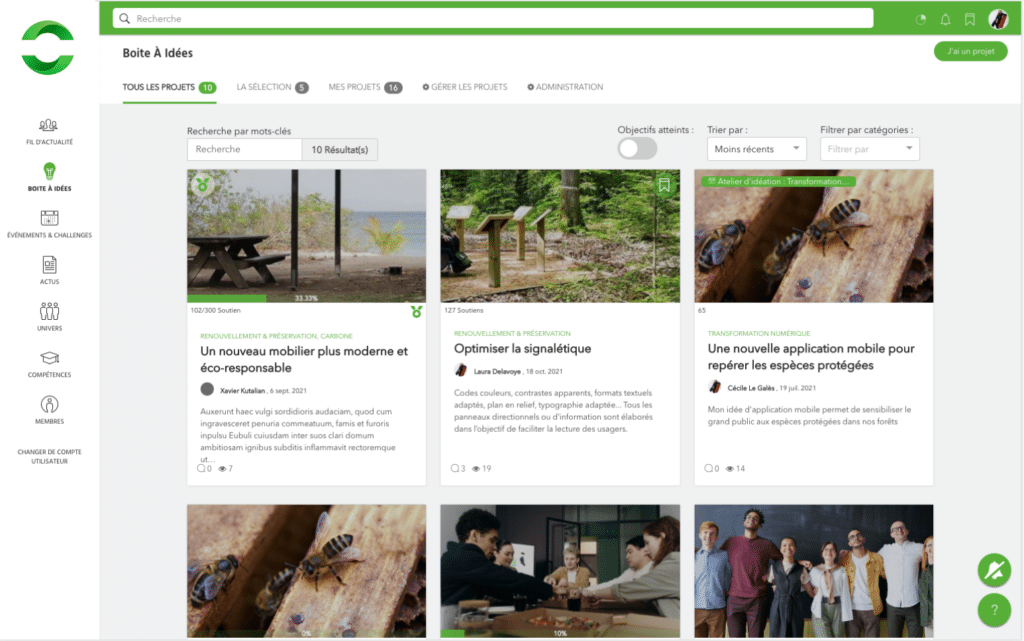Regularly, in the professional context, we are asked to think outside the box. We organise brainstorming meetings to find solutions to problems or irritants, or to imagine projections to do better, to be more efficient. In the short term, these solutions are effective. But they are not enough. If you really want your organisation to become more innovative, you will need a sustainable process to generate new ideas, follow them up, implement them. In short, you will need a process and tools for organising ideation in your company.

Why should ideation in companies be organised?
Let's start by defining ideation in business. It is a creative process of generating new ideas, developing them and creating engagement around them. Ideation has long been associated with design thinking. However, it is not just about collecting new ideas. It is also about solving problems and imagining solutions. As you can see, ideation in business must make sense.
Creating a culture of ideation is not easy. It must be accompanied by good practices to achieve a true culture of innovation.
The first good practice we can give you is to never forget the purpose of ideation, which is to bring out solutions. Keep in mind that ideation is there to be concretised, and do not stop at just collecting ideas. It is up to you to find the balance between the two.

What are the challenges of ideation in business?
As we see with our clients, certain challenges are recurrent when it comes to implementing an enterprise ideation process.
Confronting the existing culture
Every company starts ideation with its own culture, its own processes and its own tools. Your ideation system should not be in opposition to what is already in place. On the contrary, it should complement it.
The best way to do this is to make the ideation process part of a transformation process. For example, if your company is developing a digital transformation programme, there is a good chance that actions will be put in place to gain agility. Use this opportunity to instil a culture of ideation, and use ideation as a tool to be more agile and innovative. In short, ideation in business can be a wonderful tool for your transformations.
Finding the right tool for business ideation
You want to set up a sustainable ideation dynamic in your company. And you are now looking for the best ideation platform. To find it, you must first answer one question: what do you want to do with your ideation platform?
Should it be a mere suggestion box? Should it stimulate engagement? Do you want gamification? Does it need to be able to handle highlights? Do you need to acculturate your employees? Does it need to be able to run remote workshops? How do you want to manage ideas?
It also depends on how many people you want to bring on board.
It is often preferable to opt for an all-in-one tool to create a dynamic of engagement around ideation in a company. Indeed, the best ideation tools are often those capable of accompanying you in all phases of your process.
Your design tool should also be intuitive and easy to use for both administrators and users.
Don't stop at collecting ideas
Ideation is essential to boost innovation. But it is not enough. Because ideas that emerge through ideation will not magically turn into concrete projects.
Thus, many of the challenges encountered during the ideation process are related to the idea that ideation stops at collecting ideas. Indeed, the focus is on organising workshops, brainstorming, in short, anything that can help develop creativity and bring new ideas to the surface.
However, in this case, we often forget to focus on other essential elements:
- The definition of criteria for evaluating ideas
- Selection of ideas
- The organisation and implementation of challenges following a thematic planning
- And of course, the phase of experimentation and implementation of ideas
To see the whole design, you can create schedules including all the steps of your design, so that you don't forget anything.
Our best practices for successful ideation in business
What are our best practices for your business ideation process? And by the way, why do we talk about an "ideation process"?
Implementing a real ideation process
In many companies, ideation is done a lot "here and there" to solve a problem from time to time. We advise you to structure ideation in such a way that it becomes a reflex and a working method throughout the year.
To achieve this structured approach, you will need reproducible methods to implement in different situations. You can also set up an ideation calendar, with actions throughout the year. In this way, you ensure that a culture of innovation is gradually established.
In short, as with any project, ask yourself:
- What are your objectives?
- How to reach them?
- In what time frame?
- What is your target audience?
- What tools do you have and what do you need?
- Who are your allies?
- Etc.
In your plan, you will also have to choose between several ideation modes:
- Centralised ideation: with ideation spaces open to all your employees. In this case, a single committee is responsible for selecting and monitoring ideas.
- Decentralised ideation: in this case, several ideation processes take place simultaneously in different departments of your company, in a micro-managed way.
- A hybrid system: with both a part managed by a dedicated committee, but also spaces managed at a more local company level.
We generally recommend a hybrid model, but it all depends on your organisation! It's a case-by-case basis.
Breaking down silos
Whatever ideation mode you choose, it is essential for you to promote collaboration between people and between teams. Often, organising challenges is a good way tosee more collaboration emerge and break down silos. During these challenges, organise workshops that bring together people from different backgrounds.
In addition, to encourage collaboration, your communication will be essential. First and foremost, you must communicate the meaning of your business ideation process. Why do you docollaborative innovation ? What is your common goal? It is by answering these questions that you will bring people together.
Moreover, don't forget that in some companies, employees are caught up in their daily lives and easily forget the meaning of their work. Communicate to remind them of this meaning, and put your ideation process at the heart of the company project. You will see that the commitment rate of your employees will rise in the long term! The case of Renault shows a 29% increase in commitment after the implementation of a collective ideation process.

Clarify roles, and have a good sponsor
Ideally, you will need a good sponsor to carry the ideation process into the company. And a good sponsor is someone who brings people together and creates the spirit of collaboration we mentioned above.
If an inspiring sponsor takes the floor to motivate employees to participate in the ideation, there is indeed a greater chance that the mayonnaise will take off than if there were no sponsor at all.
It is also essential to clarify the roles within the organising team. For example, you can define 2 types of team:
- A strategic team whose role will be to define the themes, planning, communication methods, ideation processes, etc.
- A jury team whose role will be to select and follow up the proposed ideas
Everyone needs to know their role and what is expected of them in order to participate effectively in the process.
Establish a decision-making process and follow-up of ideas
Ideation in business starts with collecting ideas, but you cannot implement everything at once. So you will have to evaluate the ideas, select them, and eventually put them into a schedule.
Often, evaluation criteria are decided beforehand by the strategy team. These criteria can be :
- The economic impact of the idea
- The benefit to customer relations
- CSR impact
- Ease of implementation
- Etc.
The jury, or selection committee, can therefore score each idea on each of these criteria to determine which ones will be deployed first.
The vote of other collaborators can also be included in the selection criteria. Although this criterion cannot be used to make a decision on its own, it is still very interesting because it gives the "temperature of the field" regarding an idea.
In short, a good balance is needed between an evaluation by a jury on the basis of predefined criteria, and a choice based on the support or vote of all employees.
In any case, remember to communicate transparently about the selection methods and, of course, about your evaluation criteria.



